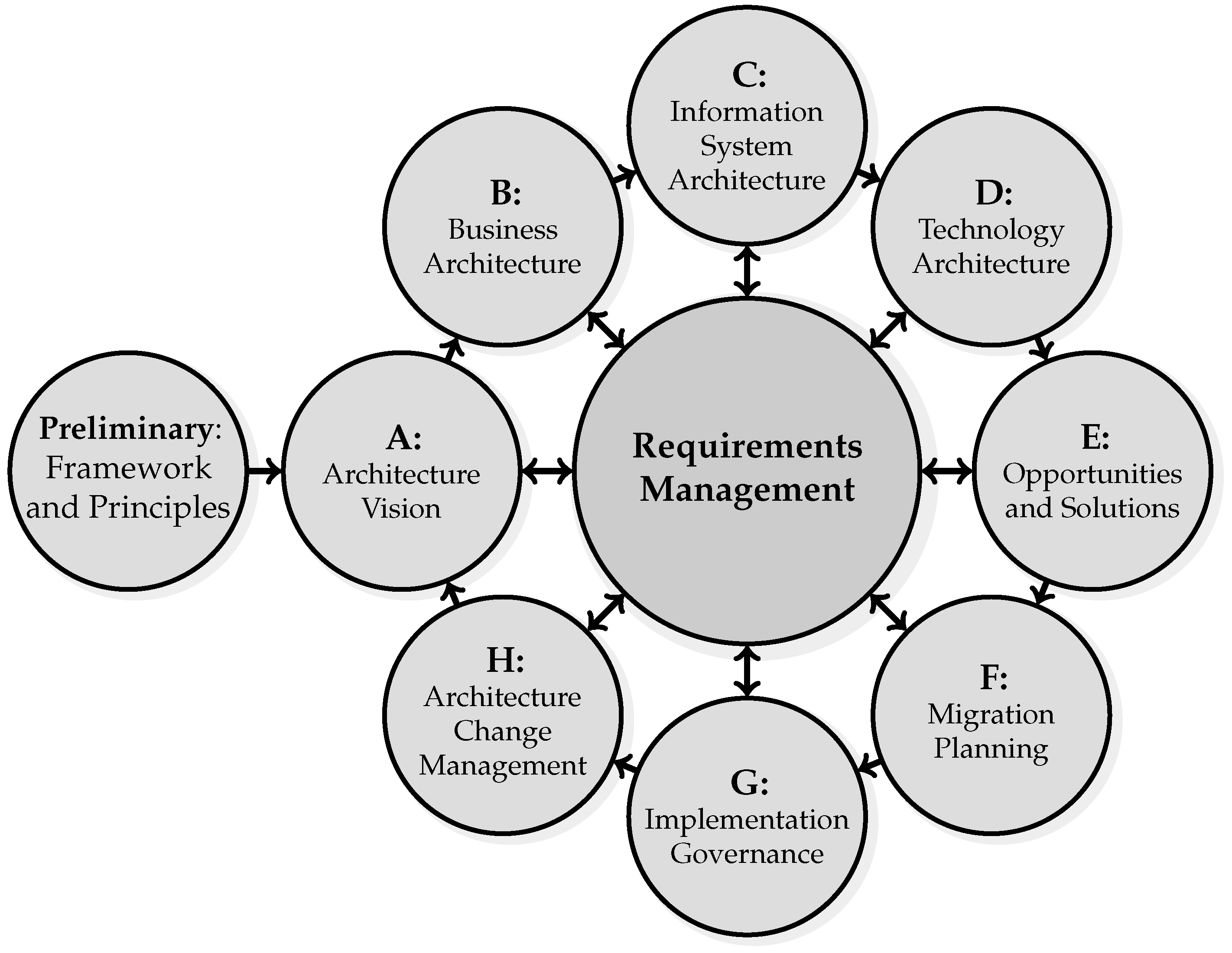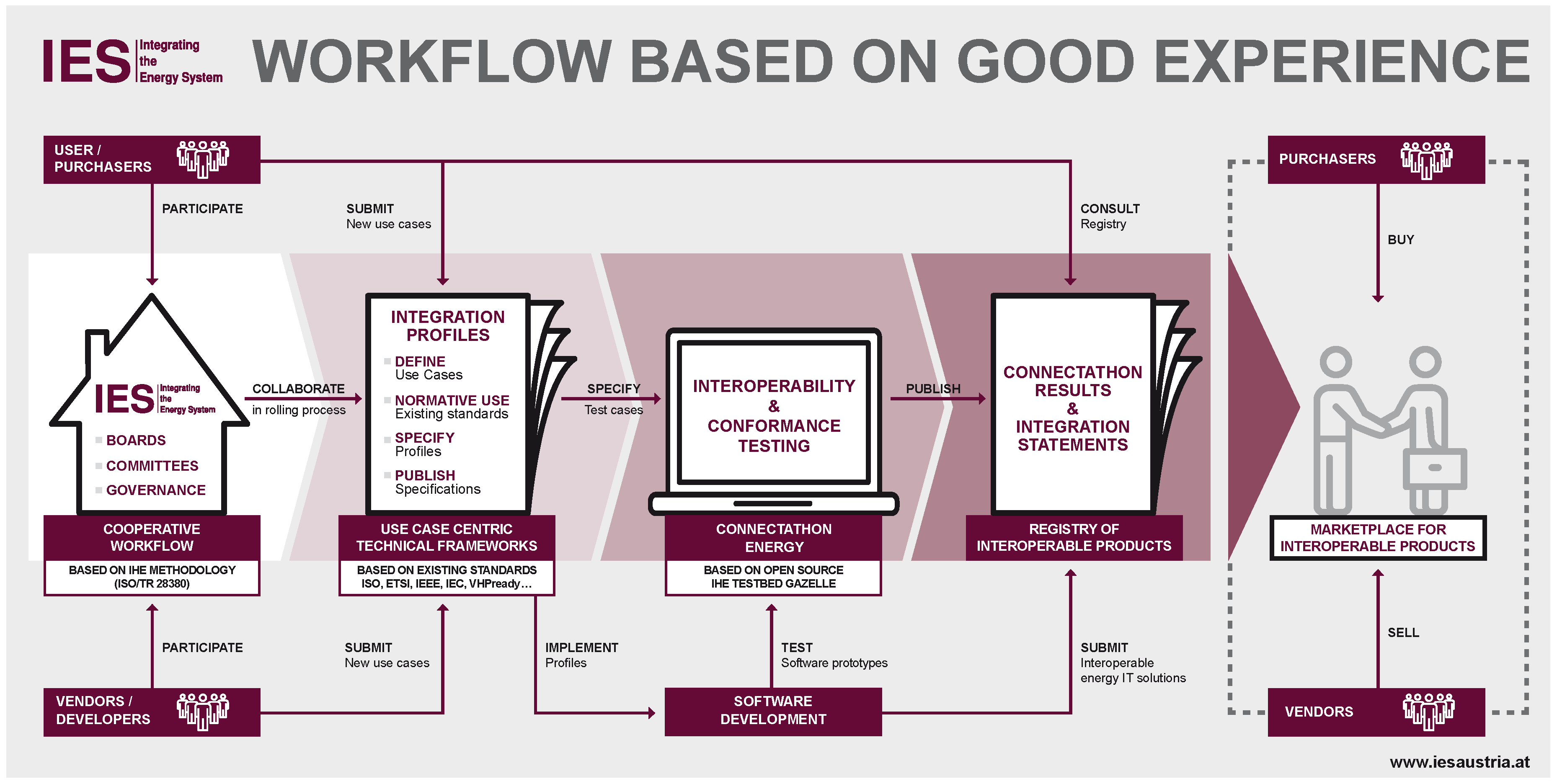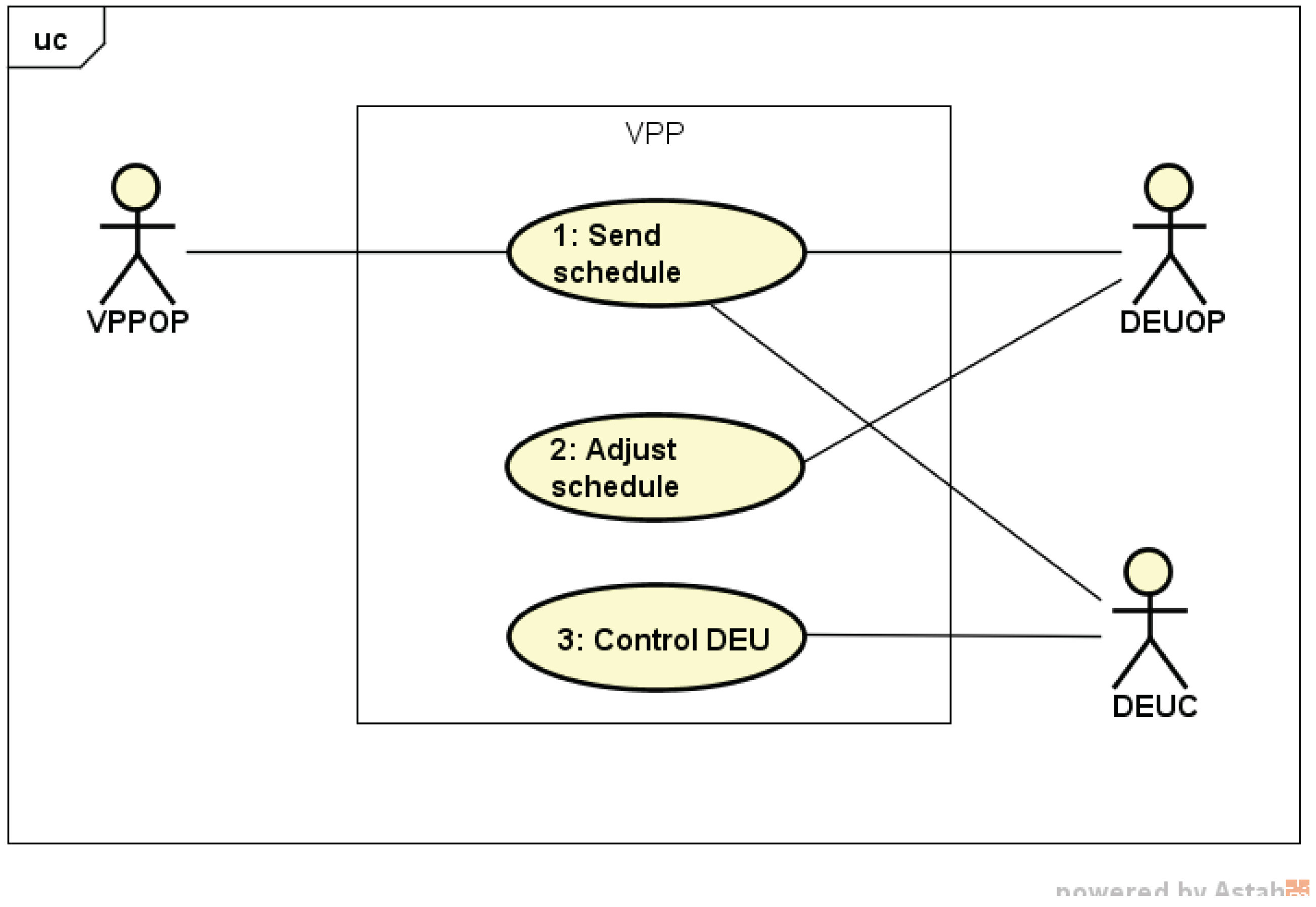From Integration Profiles to Interoperability Testing for Smart Energy Systems at Connectathon Energy
Abstract
:1. Introduction
- Transferring the IHE methodology into the energy domain,
- Providing a test environment to specify and document test cases and test sequences,
- Validation of the IES methodology via exemplary profiles for VPPs based on IEC 61850.
2. Related Work
2.1. The IEC 62559 Use Case Methodology
2.2. The Smart Grid Architecture Model (SGAM)
2.3. The Open Group Architecture Framework (TOGAF)
2.4. Integrating the Healthcare Enterprise (IHE)
- Critical aspects of information transfers are identified and thereby relevant Use Cases defined.
- IHE profiles are jointly developed to detail every communication via established standards.
- Vendors develop systems that implement the communication as specified in IHE profiles.
- The interoperability of a vendor’s system is peer-to-peer tested at Connectathon events.
2.5. Gazelle—A Test Platform for Interoperability Testing
2.6. IEC Basic Application Profiles
2.7. VHPready
3. IES Workflow Overview
- Identify Use Cases where interoperability is an issue and specify these by identifying system borders and requirements [11]:
- Write a Business Overview (define actors, the environment and the general issue),
- Describe Business Functions (apply the Use Case Methodology and draw UML use case diagrams),
- Reuse Integration Profiles where possible (save specification and test effort).
- Jointly identify how interoperability issues can be prevented and specify the requirements normatively as Integration Profile [19]:
- Evaluate which standards can be used to fulfil the Use Case requirements,
- Specify the process to realise a Business Function (UML sequence diagram),
- Define the actors and transactions (decompose Meta-Actors into modules),
- Describe the role of the individual actors (modules),
- Draw an Actors-Transactions Diagram (decompose the process into steps),
- Draw detailed UML sequence diagrams per transaction (steps sequence),
- Specify additional communication and security requirements.
- Test independent prototype solutions against each other on annual plugfest and improve the Integration Profiles until it is fixed [29]:
- Specify test cases and test sequences according to Integration Profile specification,
- Integrate test cases, procedures, and documentation in test environment (Gazelle),
- Create or integration conformity validation tools (e.g., Schematron),
- Develop simulators as dummy pre-Connectathon test partner (optional),
- Execute test cases with at least two independent peer vendors,
- Validate recorded messages/traces and log passed test results (neutral monitor),
- Publish successful test results: who has successfully tested which Integration Profile [29],
- Publish which vendors successfully tested an Integration Profile (Result Browser),
- Get written approval for successful implementation (Integration Statements).
3.1. Process Coordination and Control
3.2. Participation Benefits—Implicit and Explicit
4. Technical Frameworks
4.1. Volume One—Informative
4.2. Volume Two—Normative
- Specify semantics and syntax for the required Information pieces, i.e., how information shall be converted into data and vice versa, how information shall be handled (protection) and in which format data shall be exchanged among actors.
- Specify the transactions, i.e., the communication channel and protocol that shall be used to transport data chunks from one actor to the other.
- Specify the actors, i.e., features and characteristics of sender and receiver components (drivers) to be integrated with actors.
4.2.1. Relation to TOGAF and EIRA Architecture Building Blocks
5. Testing the Interoperability and Profile Implementation Conformance
6. Realisation of the IES Workflow
- Send MMXU: specifies how measured values are sent from a DEUC to DEUOP or VPPOP using the IEC 61850 logical node MMXU.
- Send FSCH: specifies how a functional schedule is sent from a DEUOP or VPPOP to a DEUC using the IEC 61850 logical node FSCH.
- Send DRCT: specifies how DER controller characteristics are transferred from a DEUC to a DEUOP or VPPOP according to IEC 61850.
6.1. Test Setup for Interoperability Testing at the Connectathon 2018
6.2. Interoperability testing Result—Send Functional Schedule
7. Conclusions and Outlook
Author Contributions
Funding
Acknowledgments
Conflicts of Interest
Abbreviations
| ABB | Architecture Building Block |
| ABB_spec | ABB Specifications |
| ACM | Association for Computing Machinery |
| BAP | Basic Application Profile |
| BAIOP | Basic Application Interoperability Profiles |
| CEN | European Committee for Standardization |
| CENELEC | European Committee for Electrotechnical Standardization |
| CF | Common Feature |
| CG | Coordination Group |
| CO2 | Carbon Dioxide |
| DER | Distributes Energy Resource |
| DEU | Distributed Energy Unit |
| DEUC | Distributed Energy Unit Controller |
| DEUOP | Distributed Energy Unit Operator |
| DFDL | Data Format Description Language |
| DICOM | Digital Imaging and Communications in Medicine |
| DRCT | DER Controller Characteristics |
| DSO | Distribution System Operator |
| DTR | Draft Technical Report |
| EIRA | European Interoperability Reference Architecture |
| ETSI | European Telecommunications Standards Institute |
| FFG | Austrian Research Promotion Agency |
| FIP | Functional Integration Profile |
| FSCH | Functional Schedule |
| GWAC | GridWise Architecture Council |
| HL7 | Health Level 7 |
| ICT | Information and Communication Technology |
| ID | Identification |
| IEC | International Electrotechnical Commission |
| IEEE | Institute of Electrical and Electronics Engineering |
| IES | Integrating the Energy Systems |
| IHE | Integrating the Healthcare Enterprise |
| IP | Internet Protocol |
| ISGAN | International Smart Grids Action Network |
| ISO | International Standardization Organization |
| IT | Information Technology |
| KLIEN | Austrian Climate and Energy Fund |
| LAN | Local Area Network |
| M/490 | European Mandate 490 |
| MMXU | Measurements |
| OASIS | Organization for the Advancement of Structured Information Standards |
| PHR | Personal Health Record |
| RA | Reference Architecture |
| R&D | Research and Development |
| RES | Renewable Energy Source |
| SAC | Send Asset Configuration |
| SBB | Solution Building Blocks |
| SET | Strategic Energy Technology |
| SETIS | Strategic Energy Technologies Information System |
| SG | Smart Grid |
| SGAM | Smart Grid Architecture Model |
| SMV | Send Measured Values |
| SoS | System of Systems |
| SPS | Send Planned Schedule |
| SUT | Systems Under Test |
| TF | Technical Framework |
| TOGAF | The Open Group Architecture Framework |
| TSO | Transmission System Operator |
| UML | Unified Modelling Language |
| VPN | Virtual Private Network |
| VPP | Virtual Power Plant |
| VPPOP | Virtual Power Plant Operator |
| XML | Extensible Markup Language |
| XSD | XML Schema Definition |
References
- Uslar, M.; Specht, M.; Daenekas, C.; Trefke, J.; Rohjans, S.; Gonzalez, J.M.; Rosinger, C.; Bleiker, R. Standardization in Smart Grids; Springer: Berlin/Heidelberg, Germany, 2013. [Google Scholar]
- Ramchurn, S.D.; Vytelingum, P.; Rogers, A.; Jennings, N.R. Putting the ‘Smarts’ into the Smart Grid: A Grand Challenge for Artificial Intelligence. ACM 2012, 55, 86–97. [Google Scholar] [CrossRef]
- Kroposki, B.; Johnson, B.; Zhang, Y.; Gevorgian, V.; Denholm, P.; Hodge, B.M.; Hannegan, B. Achieving a 100% Renewable Grid: Operating Electric Power Systems with Extremely High Levels of Variable Renewable Energy. IEEE Power Energy Mag. 2017, 15, 61–73. [Google Scholar] [CrossRef]
- Steg, L.; Shwom, R.; Dietz, T. What Drives Energy Consumers? Engaging People in a Sustainable Energy Transition. IEEE Power Energy Mag. 2018, 16, 20–28. [Google Scholar] [CrossRef]
- IEEE Standards Board. IEEE Standard Glossary of Software Engineering Terminology; Technical Report; Standards Coordinating Committee of the Computer Society of the IEEE: Los Alamitos, CA, USA, 1990. [Google Scholar]
- Merriam-Webster Incorporated. Definition of Interoperability. Available online: https://www.merriam-webster.com/dictionary/interoperability (accessed on 25 May 2018).
- IES Team. IES—Integrating the Energy System. Available online: www.iesaustria.at (accessed on 30 October 2018).
- Gottschalk, M.; Franzl, G.; Frohner, M.; Pasteka, R.; Uslar, M. Structured workflow achieving interoperable smart energy systems. Energy Inform. 2018. [Google Scholar] [CrossRef]
- European Commission. Digital Single Market. Available online: https://ec.europa.eu/commission/priorities/digital-single-market_en (accessed on 30 May 2018).
- IEC 62559-2:2015. Use Case Methodology—Part 2: Definition of the Templates for Use Cases, Actor List and Requirements List; IEC TC8 Standard; IEC: Geneva, Switzerland, 2015. [Google Scholar]
- Gottschalk, M.; Uslar, M.; Delfs, C. The Use Case and Smart Grid Architecture Model Approach: The IEC 62559-2 Use Case Template and the SGAM Applied in Various Domains; SpringerBriefs in Energy; Springer: Berlin/Heidelberg, Germany, 2017. [Google Scholar]
- CEN-CENELEC-ETSI Smart Grid Coordination Group. First Set of Standards; Technical Report; CEN-CENELEC-ETSI Smart Grid Coordination Group: Brussels, Belgium, 2012. [Google Scholar]
- Englert, H.; Uslar, M. Europäisches Architekturmodell für Smart Grids-Methodik und Anwendung der Ergebnisse der Arbeitsgruppe Referenzarchitektur des EU Normungsmandats M/490. In Proceedings of the Tagungsband VDE-Kongress, Stuttgart, Deutschland, 5–6 November 2012. Technical Report. [Google Scholar]
- SG-CG/RA. Smart Grid Reference Architecture; Technical Report; CEN-CENELEC-ETSI Smart Grid Coordination Group: Brussels, Belgium, 2012. [Google Scholar]
- The Open Group. TOGAF Version 9—The Open Group Architecture Framework (TOGAF), 9th ed.; The Open Group: San Francisco, CA, USA, 2009. [Google Scholar]
- Urbauer, P.; Sauermann, S.; Frohner, M.; Forjan, M.; Pohn, B.; Mense, A. Applicability of IHE/Continua components for PHR systems: Learning from experiences. Comput. Biol. Med. 2015, 59, 186–193. [Google Scholar] [CrossRef] [PubMed]
- Noumeir, R. Integrating the healthcare enterprise process. Int. J. Healthc. Technol. Manag. 2008, 9, 167. [Google Scholar] [CrossRef]
- IHE International. Gazelle—eHealth Test Framework for Interoperability. Available online: https://gazelle.ihe.net/ (accessed on 30 October 2018).
- Frohner, M.; Gottschalk, M.; Franzl, G.; Pasteka, R.; Uslar, M.; Sauermann, S. Smart Grid Interoperability Profiles Development. In Proceedings of the 2017 IEEE International Conference on Smart Grid Communications, Dresden, Germany, 23–26 October 2017. [Google Scholar] [CrossRef]
- Smart Grid Mandate. Methodologies to Facilitate Smart Grid System Interoperability through Standardization, System Design and Testing. Available online: https://www.google.com.tw/url?sa=t&rct=j&q=&esrc=s&source=web&cd=1&cad=rja&uact=8&ved=2ahUKEwie3vD7_3eAhXCEnAKHRGNCyoQFjAAegQIAxAB&url=https%3A%2F%2Fwww.researchgate.net%2Fpublication%2F322752190_Smart_Grid_Interoperability_Testing_Methodology_A_Unified_Approach_Towards_a_European_Framework_for_Developing_Interoperability_Testing_Specifications&usg=AOvVaw1MICQd3PD5VnSUZxHksKpy (accessed on 30 October 2018).
- Wolfgang, B.; Heiko, E. Basic Application Profiles for IEC 61850. 2013. Available online: https://docstore.entsoe.eu/Documents/RDCdocuments/BAP_concept_TC57WG10.pdf (accessed on 30 October 2018).
- Masera, Marcelo. The Role of Interoperability in the Digital Energy Vision. 2017. Available online: https://www.etip-snet.eu/wp-content/uploads/2017/06/2.-The-role-of-Interoperability-Marcelo-Masera.pdf (accessed on 30 October 2018).
- Forsberg, K.; Mooz, H.; Cotterman, H. Visualizing Project Management—Models and Frameworks for Mastering Complex Systems, 3rd ed.; John Wiley & Sons, Inc.: Hoboken, NJ, USA, 2005; pp. 108–116, 242–248, 341–360. [Google Scholar]
- Industry Alliance VHPready e.V. VHPready. Available online: https://www.vhpready.com/ (accessed on 30 November 2018).
- IEC 60870-5-104—Telecontrol Equipment and Systems—Part5-104: Transmission Protocols—Network Access for IEC 60870-5-101 Using Standard Transport Profiles. Available online: https://www.google.com.tw/url?sa=t&rct=j&q=&esrc=s&source=web&cd=2&cad=rja&uact=8&ved=2ahUKEwj81rL6_v3eAhUJfnAKHSfIBgYQFjABegQIBhAB&url=https%3A%2F%2Fwebstore.iec.ch%2Fpublication%2F3746&usg=AOvVaw2LLUacS4XK_It0q8rsKXnt (accessed on 30 October 2018).
- IEC 61850-7-420:2009—Communication Networks and Systems for Power Utility Automation—Part 7-420: Basic Communication Structure—Distributed eNergy Resources Logical Nodes. Available online: https://www.google.com.tw/url?sa=t&rct=j&q=&esrc=s&source=web&cd=1&cad=rja&uact=8&ved=2ahUKEwiZo4jE_v3eAhXYQd4KHX35Ab4QFjAAegQIBRAB&url=https%3A%2F%2Fwebstore.iec.ch%2Fpublication%2F6019&usg=AOvVaw2BLqlPG9vYoFh7SuXlbmGj (accessed on 30 October 2018).
- Eisl, Hubert. ELGA Erfolgreich Gestartet. 2016. Available online: http://ihe-austria.at/elga-erfolgreich-gestartet/ (accessed on 30 October 2018).
- Franzl, G.; Frohner, M.; Gottschalk, M.; Reif, V.; Koch, G.; Berger, A. Interoperabilität im Datenaustausch in der Energiewwirtschaft—Vom Use Case zum Test der Integrationsprofile. In Proceedings of the Symposium Energieinnovation 2018, Graz, Austria, 14–16 February 2018. [Google Scholar] [CrossRef]
- IHE Europe. Whitepaper on Connectathon. The IHE Connectathon. What Is It? How Is It Done? Version 004. Available online: https://www.google.com.tw/url?sa=t&rct=j&q=&esrc=s&source=web&cd=3&cad=rja&uact=8&ved=2ahUKEwjU-t_q_f3eAhWI62EKHT46BAsQFjACegQICBAC&url=https%3A%2F%2Fwww.ihe-europe.net%2Fsites%2Fdefault%2Ffiles%2FWhitePaper_Connectathon_2016.pdf&usg=AOvVaw3vNVAnPQmRWdfV5aSS8e5h (accessed on 30 October 2018).
- ISO DTR 28380-1: Health Informatics—IHE Global Standards Adoption—Part 1: Process. Available online: https://www.google.com.tw/url?sa=t&rct=j&q=&esrc=s&source=web&cd=1&cad=rja&uact=8&ved=2ahUKEwil7-W3_f3eAhUYIIgKHcYsBFYQFjAAegQIAhAB&url=https%3A%2F%2Fwww.iso.org%2Fstandard%2F63383.html&usg=AOvVaw1iuYOVXKoGsFrnfKhE6ucA (accessed on 30 October 2018).
- Europa Analytics. An Introduction to the European Interoperability Reference Architecture (EIRA) v2.1.0. Available online: https://joinup.ec.europa.eu/sites/default/files/distribution/access_url/2018-02/b1859b84-3e86-4e00-a5c4-d87913cdcc6f/EIRA_v2_1_0_Overview.pdf (accessed on 30 October 2018).
- Masi, M.; Pavleska, T.; Aranha, H. Automating Smart Grid Solution Architecture Design. In Proceedings of the 2018 IEEE International Conference on Smart Grid Communications, Aalborg, Denmark, 29–31 October 2018. [Google Scholar]
- The Open Group. Introduction to Building Blocks. Available online: http://www.opengroup.org/public/arch/p4/bbs/bbs_intro.htm (accessed on 30 May 2018).
- IHE Europe. Gazelle | IHE Europe. 2018. Available online: https://www.ihe-europe.net/testing-IHE/gazelle (accessed on 30 October 2018).
- Open Grid Forum. Data Format Description Language (DFDL) v1.0 Specification. Available online: https://www.ogf.org/documents/GFD.207.pdf (accessed on 30 October 2018).
- The Apache Software Foundation. Apache Daffodil (Incubating) | Getting Started. Available online: https://daffodil.apache.org/getting-started/ (accessed on 30 October 2018).
- Hevner, A.; Chatterjee, S. Design Research in Information Systems; Integrated Series in Information Systems 22; Springer: Berlin/Heidelberg, Germany, 2010; pp. 9–21. [Google Scholar]
- Temporary Working Group 4—Increase the Resilience and Security of The Energy System. Strategic Energy Technology Plan—Implementation Plan—Final Version—15.01.2018; Technical Report; European Commission—SETIS: Brussels, Belgium, 2018.





















| Use Case Template | Content | Viewpoint | |
|---|---|---|---|
| 1 | Description | General info: identifier, name, non-technical description, boundaries, objectives, etc. | management perspective |
| 2 | Diagram | Visual representation of the Use Case: e.g., UML Use Case Diagrams, Sequence Diagrams. | |
| 3 | Technical details | List of actors (humans/systems) involved in the Use Case with brief role explanation. | ICT experts |
| 4 | Step-by-step analysis | Technical description of implementation: data exchanged, information objects, requirements. | |
| 5 | Information exchanged | List of information objects exchanged between actors. | |
| 6 | Requirements | List of requirements that have to be adhered to actors and information objects. | |
| 7 | Common terms and definitions | Glossary of the Use Case: define the terms used. | stakeholders (if necessary) |
| 8 | Custom information | Further information/explanation that cannot be addressed elsewhere. | |
© 2018 by the authors. Licensee MDPI, Basel, Switzerland. This article is an open access article distributed under the terms and conditions of the Creative Commons Attribution (CC BY) license (http://creativecommons.org/licenses/by/4.0/).
Share and Cite
Gottschalk, M.; Franzl, G.; Frohner, M.; Pasteka, R.; Uslar, M. From Integration Profiles to Interoperability Testing for Smart Energy Systems at Connectathon Energy. Energies 2018, 11, 3375. https://doi.org/10.3390/en11123375
Gottschalk M, Franzl G, Frohner M, Pasteka R, Uslar M. From Integration Profiles to Interoperability Testing for Smart Energy Systems at Connectathon Energy. Energies. 2018; 11(12):3375. https://doi.org/10.3390/en11123375
Chicago/Turabian StyleGottschalk, Marion, Gerald Franzl, Matthias Frohner, Richard Pasteka, and Mathias Uslar. 2018. "From Integration Profiles to Interoperability Testing for Smart Energy Systems at Connectathon Energy" Energies 11, no. 12: 3375. https://doi.org/10.3390/en11123375
APA StyleGottschalk, M., Franzl, G., Frohner, M., Pasteka, R., & Uslar, M. (2018). From Integration Profiles to Interoperability Testing for Smart Energy Systems at Connectathon Energy. Energies, 11(12), 3375. https://doi.org/10.3390/en11123375





